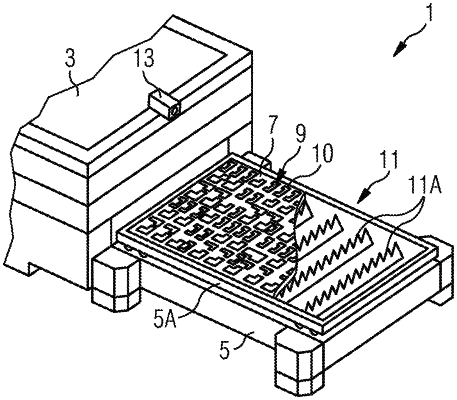| CPC B23Q 17/003 (2013.01) [B23Q 1/032 (2013.01); G05B 19/40932 (2013.01)] | 17 Claims |

|
1. A flatbed laser cutting machine system for cutting workpieces from a material sheet, the flatbed machine tool system comprising:
a flatbed machine tool comprising:
a laser processing head comprising a nozzle from which a laser beam is configured to emerge to cut the material sheet;
a pallet comprising support bars, the support bars forming a support area for the material sheet; and
a first controller configured to operate the flatbed laser cutting machine based on a nesting plan for controlling the cutting process of the flatbed laser cutting machine; and
a second controller configured to execute a method for generating the nesting plan for controlling the cutting process of the flatbed laser cutting machine
wherein the nesting plan comprises an overlap-free arrangement of sub-spaces, which correspond to the workpieces, in a two-dimensional planning space, and a spatial arrangement of predetermined supported spaces, wherein the predetermined supported spaces corresponding to support surface areas of the material sheet, which are supported during the cutting process by the support bars,
wherein the method for generating the nesting plan comprises:
providing cutting process data comprising:
geometry data of the two-dimensional planning space in which the sub-spaces can be arranged,
position data indicating positions of the predetermined supported spaces in the two-dimensional planning space,
sub-space data corresponding to a plurality of the sub-spaces each corresponding to a workpiece type, and
number data indicating quantities of the sub-spaces to be nested in the two-dimensional planning space;
providing nesting input parameters comprising:
a workpiece minimum distance that at least is present between two adjacent ones of the sub-spaces arranged in the two-dimensional planning space,
an insertion sequence according to which the sub-spaces are inserted during a sequential generation of the nesting plan, and
an arrangement rule according to which the sub-spaces are arranged spatially within the two-dimensional planning space one after the other:
arranging a first sub-space, of the sub-spaces, according to the insertion sequence and the arrangement rule in the two-dimensional planning space; and
sequentially inserting of further sub-spaces, of the sub-spaces, in accordance with the insertion sequence and the arrangement rule in the two-dimensional planning space, the arrangement rule assigning to a newly inserted sub-space, of the sub-spaces, in the two-dimensional planning space respectively an initial position in which at least one point of the newly inserted sub-space is arranged at the workpiece minimum distance from another sub-space, of the sub-spaces, previously inserted;
wherein, after each new insertion of a sub-space of the sub-spaces, the method for generating the nesting plan comprises further comprises performing a packing density evaluation and at least one evaluation incorporating the position data of the respective initial position of the newly inserted sub-space, and
wherein the method for generating the nesting plan further comprises:
setting up, based upon on an evaluation result of the packing density evaluation of the initial position of the newly inserted sub-space, a local search space that comprises at least one alternative position for the newly inserted sub-space,
evaluating the at least one alternative position with the packing density evaluation and the at least one evaluation incorporating the position data; and
comparing the evaluation results of the initial position and the at least one alternative position in order to determine, for the insertion sequence, one of the evaluated positions as a cutting position for the newly inserted sub-space, in the nesting plan.
|